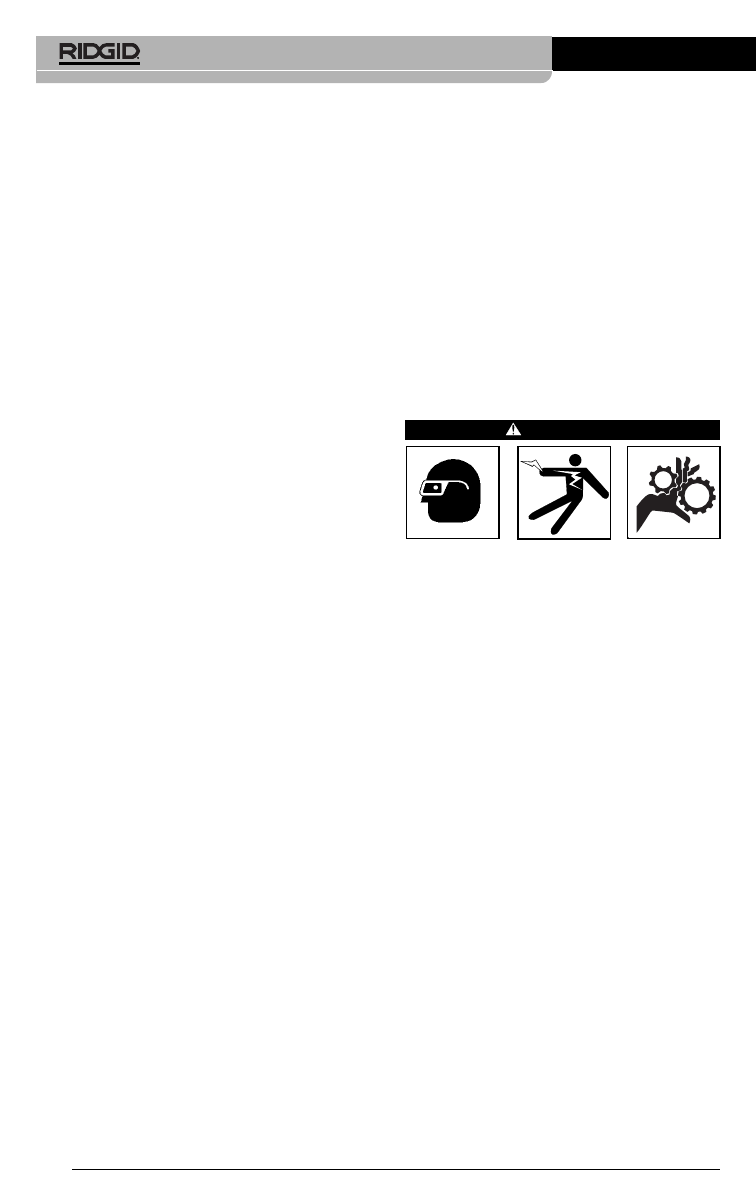
• Clear, level, stable, dry place for opera-
tor. Do not use the inspection camera
while standing in water.
2. Examine the area or space that you will
be inspecting and determine if the micro-
EXPLORER inspection camera is the
correct piece of equipment for the job.
• Determine the access points to the
space. The minimum opening the cam-
era head can fit through is approximate-
ly
3
/
4
" in diameter.
• Determine if there are any obstacles
that would require very tight turns in
the cable. The inspection camera ca-
ble can go down to a 2" radius without
damage.
• Determine if there is any electrical
power supplied to the area to be in-
spected. If so, the power to the area
must be turned off to reduce the risk of
electric shock. Use appropriate lock
out procedures to prevent the power
from being turned back on during the in-
spection.
• Determine if the any liquids will be en-
countered during the inspection. The
cable and imager head are water re-
sistant to a depth of 10'. Greater depths
may cause leakage into the cable and
imager and cause electric shock or
damage the equipment. The handheld
display unit is not water resistant and
should not be exposed to wet condi-
tions.
Determine if any chemicals are present,
especially in the case of drains. It is
important to understand the specific
safety measures required to work a-
round any chemicals present. Contact
the chemical manufacturer for required
information. Chemicals may damage
or degrade the inspection camera.
• Determine the temperature of the area
and items in the area. The working
temperature of the inspection camera is
between 32 and 113 degrees F. Use in
areas outside of this range or contact
with hotter or colder items could cause
camera damage.
• Determine if any moving parts are pres-
ent in the area to be inspected. If so,
these parts must be deactivated to pre-
vent movement during inspection to
reduce the risk of entanglement. Use
appropriate lock out procedures to pre-
microEXPLORER
™
DigitalInspection Camera
Ridge Tool Company
8
vent the parts from moving during the
inspection.
If the microEXPLORER inspection camera
is not the correct piece of equipment for the
job, other inspection equipment is available
from Ridge Tool. See the Ridge Tool catalog
on line at www.RIDGID.com, or call Ridge
Tool Technical Services at (800) 519-3456.
3. Make sure the inspection camera has
been properly inspected.
4. Install the correct accessories for use in
the appropriate application.
Operating Instructions
WARNING
Always wear eye protection to protect
your eyes against dirt and other for-
eign objects.
Follow operating instructions to reduce
the risk of injury from electrical shock,
entanglement and other causes.
1. Read the entire manual to become famil-
iar with safety procedures, operating in-
structions and on screen navigation.
2. Charge battery by following instructions
found in the “
Charging Procedure/Oper-
ating Instructions”
section.
3. Install the battery by following the instruc-
tions found in the
“To Remove or Install
the Battery Pack”
section.
4. Remove the rubber cover and insert an
SD card (if needed) as seen in the
“To
Install An SD Card”
section.
5. Make sure that the inspection camera
and work area have been properly set up
and the work area is free of bystanders
and other distractions.
6. Turn the power on using the ON/OFF
button.
There is no need to remove the
rubber cover when turning the power on
and off. Simply push the raised ON/OFF
button.
7.
See sections on Controls, Icons and On
Screen Navigation.


















